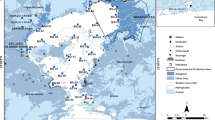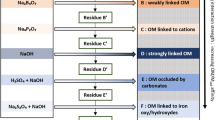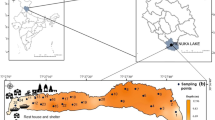Abstract
A multiproxy approach including bulk organic carbon, δ13C, lignin phenols, and lipid biomarker analyses were applied to characterize the source and composition of sedimentary organic matter in the head part of Three Gorges Reservoir. OM consisted of both natural (autochthonous and allochthonous) and anthropogenic inputs. The natural OM included input from vascular plants, especially non-woody angiosperms. The allochthonous input included plankton and microbial production, likely due to localized eutrophication. Anthropogenic inputs likely derived from petroleum input and/or urban activities. Other anthropogenic inputs were untreated sewage waste. These influences were concluded to be regionally specific point sources of pollution based on relative distributions and on the fact that molecular characteristics of sedimentary OM were not distributed smoothly along a gradient.
Similar content being viewed by others
Explore related subjects
Discover the latest articles, news and stories from top researchers in related subjects.Avoid common mistakes on your manuscript.
1 Introduction
Three Gorges Reservoir (TGR), the largest reservoir in the world with a total area of 380,000 km2, has received attention due to its significant “reservoir effect,” associated human and industrial development activities, and potential effects of these activities on environmental health. Even with many studies focusing on organic matter (OM) sources and compositions in TGR and the Changjiang River continuum, OM source characterization of the sediments is rare (e.g. Wu et al. 2016). In order to better understand the regional carbon cycle and the severity of environmental changes in this system, a multi-tracer concept was applied using bulk total organic carbon (TOC), δ13C, and molecular biomarkers to assess natural and anthropogenic sources of OM in the TGR environment.
2 Samples and methods
In this study, typical surface sediments were collected from the main stream along a west-to-east gradient of decreasing topography, and a typical branch stream near the dam (Fig. 1). Surface sediments (0–2 cm) were analyzed for bulk TOC and total nitrogen (TN) contents, and δ13Corg. Lignin phenols and lipid biomarkers (saturated and aromatic hydrocarbons, alcohols, fatty acids, steroids, triterpenoids, etc.) were analyzed using an Agilent 5977A mass spectrometer coupled with an Agilent 7890 gas chromatograph following methods described previously (He et al. 2014, 2015a, b; Cui et al. 2017).
3 Results and discussion
3.1 Bulk characteristics of Three Gorges Reservoir sediments
The TOC and TN contents of the sediments from TGR ranged from 0.73% to 1.13% and 0.10% to 0.13% (Table 1), respectively, similar to those from other river reservoir environments (e.g. Mendonça et al. 2014). The δ13Corg ranged from −26.2‰ to −24.9‰, and captured a general terrestrial input signal. The TOC and TN at stations near the dam (M3 and M4) were generally higher than those of the other sites (M1, M2, and B1), while the δ13Corg of all samples were variable, with no obvious trend observed, probably reflecting the complex hydrodynamics of this reservoir system due to water management and its effects on grain size distribution and associated bulk characteristic parameter distribution.
3.2 Identification of organic matter sources of Three Gorges Reservoir sediments
Identifying natural (autochthonous vs. allochthonous) and anthropogenic OM inputs to rivers is important in aquatic ecosystems that are heavily impacted by urban or agricultural activities (e.g. Pisani et al. 2013). Based on total extractable organic compounds (EOC), the dominant source detected in these surface sediments was allochthonously higher plant–derived OM. This is indicated by the high carbon preference index (CPI) values (2.3–5), and the distribution of higher chain homologous lipid compounds (n-alkanes, n-alkanols, n-alkanoic acids), hentriacontane-16-one, pentatriacontane-18-one, steroids, and triterpenoids (Fig. 2a). Λ8 contents (1.10–1.54 mg 100 mg/OC; Table 1) showed strong negative correlation with bulk δ13Corg (R2 = 0.82). This suggests either vascular plants as the major contribution of biospheric OC, or the dilution effect from petrogenic OC that may have a different δ13C value. Through ramped pyrolysis analysis, we observed a significant amount of petrogenic OC in the sediment. The ranges of syringyl/vanillyl (S/V) and cinnamyl/vanillyl (C/V) ratios indicate similar non-woody angiosperm sources across all stations, which is further supported by the detection of high amounts of triterpenoids, including α- and β-amyrins (amyrones), oleanolic acid, ursolic acid, and the absence of diterpenoids (except a trace amount of dehydroabietic acid).
GC trace (partial) of the sediment at M4, closest to the Three Gorges Dam. Note MAGE mono alkyl glycerol ether, MAG mono alkyl glycerol, Ph phenanthrene, A anthracene, Fl fluoranthene, Pyr pyrene, BaA, Chyr chrysene, Trip triphenylene, Be[e]P Benzo[e]pyrene, Be[a]P, Benzo[a]pyrene, IP, BghiP Benzo[ghi]perylene, Benzo[ghi]perylene, Ts 22, 29, 30-Trisnorneohopane, Tm 22, 29, 30-Trisnorhopane, DHA dehydroabietic acid, respectively
Autochthonous OM sources were detected—especially in the branch stream site and the main stream site (B1 and M4) closest to the dam—possibly associated with higher planktonic primary productivity resulting from nutrient enrichments from agricultural/urban activities and due to a significant increase in water retention time (Xu et al. 2009). Autochthonous OM was characterized by an elevated presence of lower molecular weight and unsaturated n-alkanoic acids (Cmax 18 or 16). These lower molecular weight fatty acids in aquatic samples have usually been assigned to recent autochthonous OM, since they are considered to be short-lived in the environment (Medeiros and Simoneit 2008). In addition, OM input from microorganisms (bacteria and algae) were indicated by the presence of lower molecular weight branched-alkanoic acids, two mono-alkyl glycerol ethers (MAGEs; Fig. 2c), and a C25:2 HBI (Fig. 2d) (Hernandez-Sanchez et al. 2014; He et al. 2016). The variations of these autochthonous biomarker abundances are likely a result of site-specific nutrient conditions, possibly due to variations in eutrophication status and composition of pollution point sources.
In addition to natural products, all the sediments also contained various biomarkers indicative of anthropogenic OM. For example, the sediments showed obvious petroleum residue [17α(H),21β(H)-hopane series, β-carotane; Fig. 2d, e]. The petroleum biomarkers pristane, phytane, and an unresolved complex mixture (UCM) detected in the saturated hydrocarbon fraction of all samples may be a result of petroleum related pollution by frequent boat traffic in the reservoir system. However, we cannot rule out the significant input of petrogenic OC due to extensive bedrock weathering upstream (Fig. 2b). Furthermore, the presence of coprostanol, copro-sitosterol and epi-coprostanol, and high ratios of coprostanol/(coprostanol + cholestanol) (Fig. 2b; Table 1) in all samples indicate measurable domestic untreated sewage input and further microbial epimerization in these areas (Bull et al. 2002; Rogge et al. 2006). Trace amounts of 5β-campestanol and 5β-stigmast-22-enol were detected at some sites, suggesting minor input from animal waste (Rogge et al. 2006). Many of the samples where fecal sterols (and related stanols) were identified also featured relatively high microbial OM, implying that sewage discharge may affect the trophic status of the head of the TGR system. Various polycyclic aromatic hydrocarbons (PAHs) were detected (Fig. 2f), including both low and high molecular weight PAHs, implying incomplete combustion of biomass, coal, and petroleum due to both agricultural and industrial activities (Simoneit 2002). Specific PAH ratios such as Fl/Py, P/A, IP/(IP + Bghi) and Fl/(Fl + Py) generally suggest the main sources of PAHs detected here were petroleum and combustion rather than biogenic inputs. These consistent detections of anthropogenic compounds suggest an overarching influence of human and industrial development activities, including drivers such as urbanization and population center growth, land-use change to support agricultural production and animal husbandry, and petroleum pollution. These influences were found to be regionally specific based on the relative distribution of biomarkers measured and on the fact that the molecular characteristics of sedimentary OM were not distributed smoothly west-to-east.
4 Conclusions
Specific biomarkers were determined in order to assess OM sources in the TGR area. While the majority of the OM inputs to sediments were derived from terrestrial vegetation, contributions from microbial and anthropogenic sources (pollution from urbanization and agricultural practices) were also evident. The observed regional variability in the molecular marker distributions suggests clear influences of point sources of both natural and anthropogenic OM, possibly due to the complex hydrodynamic sorting process of TGR. Upper main stream and branch stream sites were found to be more prone to pollution by sewage discharge and agricultural runoff. Since the supply of OM, both natural and anthropogenic, can have important implications for aquatic ecosystems, the sedimentary OM source assessment and the data presented here should be considered in future assessments on the effects of regional development, urbanization, and land-use change in the TGR ecosystem.
References
Bull ID, Lockheart MJ, Elhmmali MM, Roberts DJ, Evershed RP (2002) The origin of faeces by means of biomarker detection. Environ Int 27:647–654
Cui X, Bianchi TS, Savage C (2017) Erosion of modern terrestrial organic matter as a major component of sediments in fjords. Geophys Res Lett 44:1457–1465
He D, Mead RN, Belicka L, Pisani O, Jaffé R (2014) Assessing source contributions to particulate organic matter in a subtropical estuary: a biomarker approach. Org Geochem 75:129–139
He D, Simoneit BR, Jara B, Jaffé R (2015a) Compositions and isotopic differences of iso-and anteiso-alkanes in black mangroves (Avicennia germinans) across a salinity gradient in a subtropical estuary. Environ Chem 13:623–630
He D, Simoneit BR, Jara B, Jaffé R (2015b) Occurrence and distribution of monomethylalkanes in the freshwater wetland ecosystem of the Florida Everglades. Chemosphere 119:258–266
He D, Simoneit BR, Xu Y, Jaffé R (2016) Occurrence of unsaturated C25 highly branched isoprenoids (HBIs) in a freshwater wetland. Org Geochem 93:59–67
Hernandez-Sanchez MT, Homoky WB, Pancost RD (2014) Occurrence of 1-O-monoalkyl glycerol ether lipids in ocean waters and sediments. Org Geochem 66:1–13
Medeiros PM, Simoneit BR (2008) Multi-biomarker characterization of sedimentary organic carbon in small rivers draining the Northwestern United States. Org Geochem 39:52–74
Mendonça R, Kosten S, Sobek S, Cole JJ, Bastos AC, Albuquerque AL, Cardoso SJ, Roland F (2014) Carbon sequestration in a large hydroelectric reservoir: an integrative seismic approach. Ecosystems 17:430–441
Pisani O, Oros DR, Oyo-Ita OE, Ekpo BO, Jaffé R, Simoneit BR (2013) Biomarkers in surface sediments from the Cross River and estuary system, SE Nigeria: assessment of organic matter sources of natural and anthropogenic origins. Appl Geochem 31:239–250
Rogge WF, Medeiros PM, Simoneit BR (2006) Organic marker compounds for surface soil and fugitive dust from open lot dairies and cattle feedlots. Atmos Environ 40:27–49
Simoneit BR (2002) Biomass burning-a review of organic tracers for smoke from incomplete combustion. Appl Geochem 17:129–162
Wu Y, Bao H, Yu H, Zhang J, Kattner G (2016) Temporal variability of particulate organic carbon in the lower Changjiang (Yangtze River) in the post-three gorges dam period: links to anthropogenic and climate impacts. J Geophys Res Biogeosci 120:2194–2211
Xu Y, Cai Q, Shao M, Han X, Cao M (2009) Seasonal dynamics of suspended solids in a giant subtropical reservoir (China) in relation to internal processes and hydrological features. Quat Int 208:138–144
Acknowledgement
The authors appreciate the assistance and advise of Junwei Zhang during sample collection. The assistance of Qingyuan Lu during the sample preparation is highly appreciated. This work is supported by the “100” talent program of Zhejiang University to D. He under the Grant No. 188020*194231701/008 and 188020-193810201/102, and NSFC to Y. Sun under the Grant No. 41372131.
Author information
Authors and Affiliations
Corresponding author
Additional information
11th International Symposium on Geochemistry of the Earth’s Surface.
Rights and permissions
About this article
Cite this article
Ding, H., Zhu, C., Zhang, K. et al. Source and composition of sedimentary organic matter in the head of Three Gorges Reservoir: a multiproxy approach using δ13C, lignin phenols, and lipid biomarker analyses. Acta Geochim 36, 452–455 (2017). https://doi.org/10.1007/s11631-017-0189-8
Received:
Revised:
Accepted:
Published:
Issue Date:
DOI: https://doi.org/10.1007/s11631-017-0189-8






